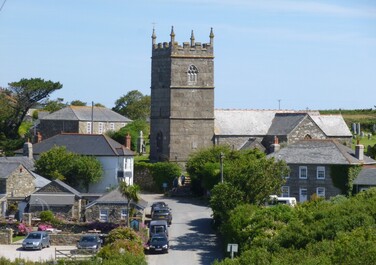A Short History

There has probably been a small Celtic church on this site since the sixth century AD. The circular graveyard is an Iron Age site overlaying the Stone and Bronze Age boundaries of this ancient land. Our patron saint, Senara, is linked to the legendary Breton princess Asenora, who may have travelled from Ireland to Brittany in the wave of Celtic Christianity which spread into Cornwall during that time. The earliest record of this building dates from 1150. The tower was built, and an aisle was added on to the north side in 1450. The whole church was restored in 1890.
On entering the church there is an octagonal sandstone font dating from the 13th or 14th century which is still in use today. The nave and chancel have the typical Cornish barrel-vaulted ceiling, made in the manner of a ship’s keel.
To the right of the main aisle is the side chapel, one of the oldest parts of the church, with a granite altar and a ‘squint’ (a peephole) into the chancel and main altar. One of the windows with a theme of the sea is dedicated to Admiral Borlase who is buried in the church yard. Here also is the Mermaid Chair, the only remaining Mediaeval bench end carved over 500 years ago and linked to the legend of the chorister, Matthew Trewhella. It is said he was lured into the sea at Pendour Cove by the mermaid who came into the church to hear his beautiful singing.
To the right of the main altar in the chancel is a piscina (probably Norman) originally used in ritual cleaning during holy communion. The window nearest to the pulpit shows St Senara holding the church. A small ancient statue of a saint rests in the corner.
Along the vestry wall are photos of the church before it was restored in 1890 and a list of vicars showing all the priests since 1271. To the left of the recently restored organ a model of a West Country Schooner hangs from the ceiling in memory of W.A. Proctor who died on a single-handed voyage around the world. It is also a memorial to all unnamed sailors in the churchyard who were shipwrecked on this coast.
On the north side of the church there is a window presented by the local branch of the Burma Star Association dedicated to the armed forces who fought in Burma in the second World War. At the back of the church is a second font, believed to be Norman, found buried in the vicarage garden and restored in 1960.
The Bell Tower contains six recently rehung bells which are rung regularly. Records show one to be possibly from the 15th century and two others to be over two hundred years old. Our recent restoration was partly funded by the Heritage Lottery. Around the walls of the tower are seven slate memorial stones with interesting inscriptions dating from the 18th and early 19th centuries.
Outside on the south wall of the church is a plaque, commemorating John Davey of Boswednack, Zennor who was one of the last people with a traditional knowledge of the Cornish language. He died in 1891, aged 79. Nearby is a Sundial made in 1737 by Paul Quick and showing symbols of both death (cross bones) and immortality (angel’s head & wings). There is also a small gargoyle.
The graveyard contains several interesting graves. The large grave of the Borlase family is topped by two ancient granite way side crosses. The tall Celtic cross honours John Weslake, one of the founders of the code of international law. The artists Patrick Heron and Brian Wynter are buried here along with the ashes of Vera Atkins who co-ordinated French resistance fighters in World War II. The unusual war memorial, designed by architect George Kennedy and carved by the sculptor Ursula Edgecombe, commemorates those who gave their lives in 20th century conflicts.